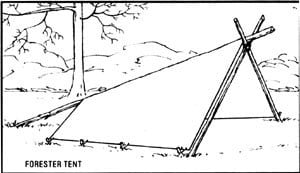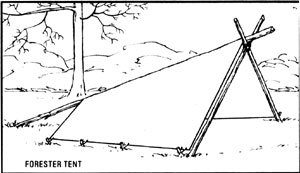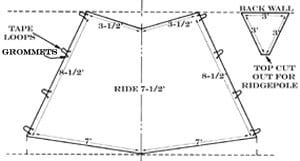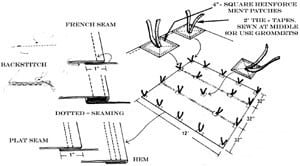
‘If you need to cut weight or cost, the Forester tent is a good solution. It’s one of the best tents ever devised for a chronic woods loafer, particularly for one who yearns to live close to nature and who objects to spending any of his or her outdoor hours confined in a closed canvas or nylon cell.
The Forester tent is the cheapest of all wilderness tents, either to make yourself or to buy. It’s the easiest and quickest to construct and pitch, too. And considering its scant weight and bulk, it’s the most comfortable in which to live and do your few camp chores. Also, with the exception of the Whelen lean-to tent, it’s the easiest to warm with a campfire out front.
The one weak point of the Forester, at least at first glance, is that if you try to fly proof it, you’ll ruin its inexpensiveness and functional simplicity. In bug time, however, it’s an easy matter to buy a mosquito bar to drape over the front opening . . . or to make one yourself, or to hang or stake a net closure over your bed.
The Forester tent is triangular in shape when pitched. The smallest practical dimensions for one person, or for two who don’t mind a bit of crowding, is about 7′ wide at the open front, 3′ wide at the back, and 7′ deep from front to rear. The peak should stand about 6′ above the ground in front, while the triangular rear will be some 3′ high. With the entire tent open to the fire in front, the angles are such that heat and light will be reflected throughout the sheltered area. It is, of course, a tent for the wilderness, where poles and firewood are plentiful. This tent is usually pitched with three poles and eight stakes cut at the campsite. The ridgepole should be long enough to extend from the peak and to pass down and out through the opening at the top of the back wall, at such a tilt that it will rest on the ground about 3′ behind the tent. Two shorter poles are arranged in front as a bipod brace and, holding the ridgepole at their crossing, run from the peak to the front corners.
The size illustrated in the Image Gallery is for one or two campers, with beds arranged along the side walls. The model I use is made of closely woven, waterproofed cotton that weighs five ounces per square yard, cut and sewn to the shape and dimensions shown in the Image Gallery, with an extra inch being allowed around the edges for hemming.
Note how the bottoms of the sides are angled back 1′ to make the tent sit right on the ground. To do this, cut your pattern from rectangular canvas as shown by the dotted lines (see Image Gallery), then angle the front and back. The piece for the rear wall is cut off square at the top, so that when it’s stitched to the main body of the tent at the rear, a hole is left at the top of the back wall through which the ridgepole can extend. Total weight for this size Forester tent is about four pounds.’
NB: This weight assumes 5 oz/sq yd canvas is used. If using 1.75 oz/sq yd Tyvek, 1.3 oz/sq yd silnylon or .51 oz/sq yd cuben fibre the weight will be correspondingly much less. You could easily add two ‘wings’ or storm flaps to the front which could be closed at need, and a sewn in floor of (eg 1.3 oz silnylon waterproofed as described here http://jwbasecamp.com/Articles/Silnylon1/index.html) and two overlapping flaps of .7 oz/sq yd insect mesh. You could have an excellent standing room ‘fire tent’ which weighs between 500 grams and 1 kg depending upon materials. PS: I would not leave the gap for a ridgepole. These lighter weight materials don’t need a ridgepole at all but can be simply pegged out – a ridgepolepole also only creates a drip line. You can simply erect it with vertical poles front and rear.
I have made this tent up in Tyvek and it works well enough indeed. I made my won version of it as well as you can see. I also have to confess that it has been the inspiration for my any open fire tents I have posted here.
See also:
http://www.theultralighthiker.com/new-tyvek-forestertent-design/
http://www.theultralighthiker.com/the-deer-hunters-tent/




Interesting to see this on an ultralight hiking website. 😉
Usually the only shelters one see from old bushcraft texts in today’s world are mids and tarps.
Hi Dave, Have a go at making one out of Tyvek. I think you will like it very much! AND it will be quite satisfactorily light – WELL under a kilo including groundsheet! Cheers, Steve,